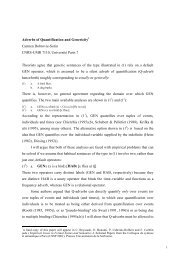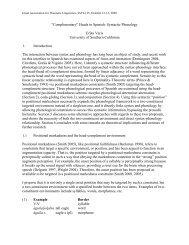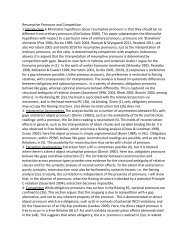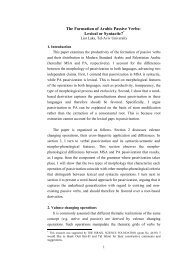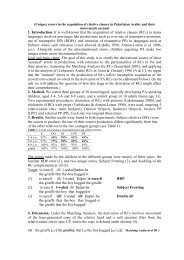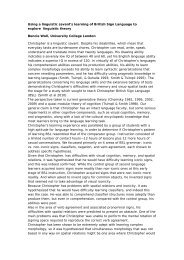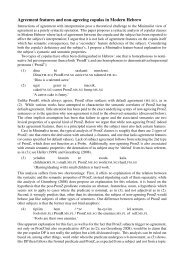paper
paper
paper
You also want an ePaper? Increase the reach of your titles
YUMPU automatically turns print PDFs into web optimized ePapers that Google loves.
to their subjects and/or complements. Generally, Russian nouns can take bare instrumental<br />
NP complements, e.g. upravlenie predprijatiem(’administration [of] company.Instr’),<br />
uvlečenie lingvistikoi (’passion [for] linguistics.Instr’) and so on. 8 . The Russian s does not<br />
inflect and cannot be possessed. But it exactly the properties of some Russian nouns: pal’to<br />
or kofe, for example, do not inflect in Russian; and they cannot appear in the possessive<br />
form either.<br />
Such an analysis has several immediately appealing aspects. First, it insures the right number<br />
specification of the mother NP. Second, it predicts that when a possession relation<br />
holds between the entities denoted by the comitative coordinate NP, a reflexive pronoun is<br />
required. Third, the first NP always varies in case in accord with the grammatical relation<br />
it bears, while the second is invariably in instrumental case. Moreover, it predicts that only<br />
non-pronominal NP’s will participate in s-coordination and provides grounds upon which<br />
to explain constrasts between comitative coordinates and ordinary coordinates on the one<br />
hand, and between comitative coordinates and Plural Pronoun Constructions on the other.<br />
Consider the following example:<br />
(42) Sveta<br />
Sveta<br />
so<br />
with<br />
svoei<br />
self’s<br />
sestroi<br />
sister<br />
eli<br />
ate<br />
pirog.<br />
pie<br />
Sveta and her sister were eating the pie.<br />
In this example, since Sveta is the subject and svoei sestroi is a complement of the same<br />
nominal head s, Sveta is the s-binder of svoju and Sveta s-commands the phrase svoju sestru.<br />
According to clause iii of (34), if Sveta s-commands the whole phrase, it s-commands<br />
its head sestroi. Svoei is an adjunct of sestroi and therefore belongs to the ARG–ST of<br />
sestroi. Applying ii of (34), one can see that Sveta s-commands svoei. Thus, keeping in<br />
mind the binding theory proposed in the previous section and defining the structure for<br />
comitative construction as in (41), we can account for the peculiar behavior of comitative<br />
coordination.<br />
8 It is interesting to notice that the cases of noun-into-preposition or preposition-into-noun conversion have<br />
been registered in different languages. See Longobardi (2001) for the reanalysis of Latin casa ’(at) the home<br />
(of)’ as a preposition in various Romance languages.



